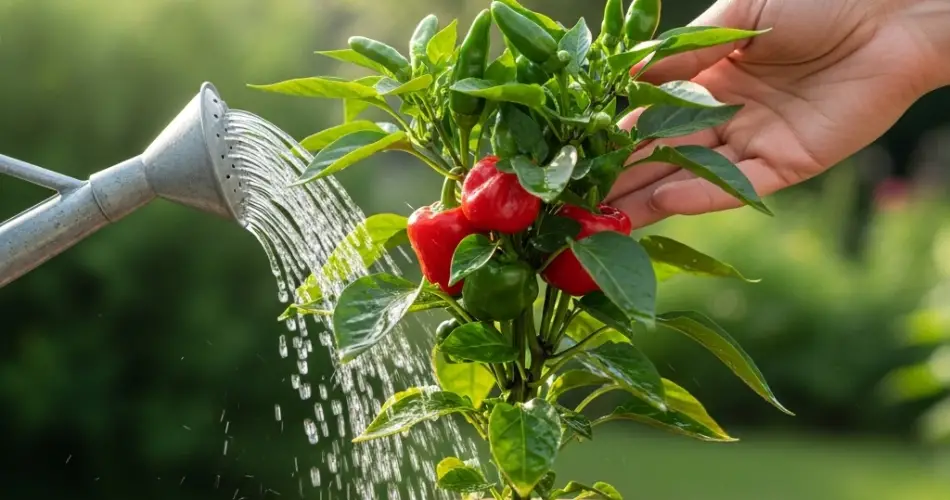Peppers are a favorite in gardens worldwide, appreciated for their vibrant colors, flavors ranging from mild to fiery, and versatility in cooking. Whether you grow bell peppers, chili peppers, or specialty varieties, one thing gardeners consistently seek is how to maximize plant health and boost their pepper harvests.
The secret to achieving rapid growth and abundant yields lies not only in good planting practices but also in timely and effective feeding. Providing your pepper plants with the right nutrients at the right time can transform weak, slow-growing plants into robust, fruitful bushes.
This article will explain why feeding peppers properly is essential, introduce a natural and powerful feeding solution, and provide clear instructions on how and when to use it for the best results.
Why Proper Feeding is Crucial for Peppers
Peppers have specific nutritional needs to support their growth stages—from seedling development to flowering and fruiting. When plants lack essential nutrients or are stressed, their growth slows, flowering is reduced, and fruit set suffers. Common signs of poor nutrition in peppers include:
-
Small, yellowing leaves
-
Thin, weak stems
-
Reduced flowering or flower drop
-
Fewer and smaller peppers
-
Increased susceptibility to pests and diseases
A targeted feeding strategy helps prevent these problems by supplying the key nutrients peppers need: nitrogen, phosphorus, potassium, and trace minerals like magnesium, calcium, and iron.
The Benefits of a Natural Feeding Solution
While many commercial fertilizers are available, using a natural feeding solution offers several advantages:
-
Improves soil health by fostering beneficial microbial life
-
Delivers nutrients gently, reducing the risk of overfeeding or chemical buildup
-
Supports plant immunity through natural growth stimulants
-
Enhances nutrient uptake efficiency by strengthening root systems
Such natural feedings often include ingredients like seaweed extract, compost tea, molasses, and organic mineral sources, creating a balanced boost that peppers thrive on.
How to Prepare and Use This Feeding Solution
Here’s a simple recipe to prepare a natural, nutrient-rich feeding for your pepper plants:
Ingredients:
-
1 liter of water (rainwater or filtered is best)
-
1 tablespoon of well-rotted compost or compost tea
-
1 teaspoon of liquid seaweed extract or aloe vera juice (rich in trace minerals and growth hormones)
-
1 teaspoon of molasses or honey (to feed beneficial microbes)
-
Optional: 1 teaspoon of wood ash (provides potassium and calcium)
Instructions:
-
Mix all ingredients thoroughly in a watering can or bucket.
-
Stir well to dissolve and distribute the components evenly.
When and How to Apply
-
Timing: Start feeding your pepper plants about 2–3 weeks after transplanting when they have established a good root system and show active growth.
-
Application: Water each plant at the base with approximately 150–200 ml of the feeding solution. Avoid wetting the foliage to reduce fungal disease risk.
-
Frequency: Apply this feeding every 10 to 14 days during the growing season, especially during flowering and fruit development stages.
Expected Results After Feeding
When your peppers receive this natural feeding regularly, you can expect:
-
Rapid and vigorous plant growth with thicker stems and greener leaves
-
Stronger root systems that improve water and nutrient uptake
-
Increased flower production leading to more fruit set
-
Improved resistance to common pests and diseases
-
Bigger, healthier peppers with richer colors and flavors
Many gardeners notice a marked improvement in their pepper plants’ vitality and harvest size just a few weeks after beginning this feeding regimen.
Additional Tips for Growing Healthy, Productive Peppers
To get the most out of your pepper plants, combine feeding with good gardening practices:
-
Plant in well-drained, fertile soil: Peppers dislike waterlogged roots, so ensure good drainage and enrich soil with organic matter before planting.
-
Maintain consistent moisture: Peppers need regular watering but avoid overwatering, which can cause root rot.
-
Use mulch: Mulching helps retain moisture, suppress weeds, and moderate soil temperature.
-
Provide adequate sunlight: Peppers thrive in full sun, ideally 6–8 hours daily.
-
Support plants as needed: Larger pepper varieties may require staking or cages to keep fruit off the ground and reduce disease risk.
Why This Natural Feeding Works So Well
This feeding method works by not only providing essential nutrients but also by enhancing soil life and natural plant defenses. The organic ingredients promote healthy microbial activity, which helps break down nutrients and makes them more available to plants. Growth hormones in seaweed or aloe vera stimulate cell division and root expansion, while molasses feeds microbes and energizes plants.
Compared to synthetic fertilizers, this approach builds a sustainable growing environment, leading to stronger plants season after season.
Conclusion
If you want your pepper plants to grow quickly, stay healthy, and produce an abundant harvest, regular feeding with this natural solution is key. By preparing a simple nutrient-rich mixture and applying it consistently, even beginner gardeners can see impressive improvements in pepper growth and yield.
So, give your peppers this natural boost and enjoy the satisfaction of picking vibrant, flavorful peppers throughout the growing season. Healthy plants make gardening more rewarding and your harvest more plentiful!



